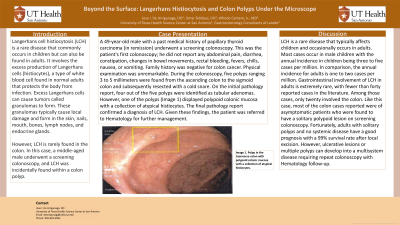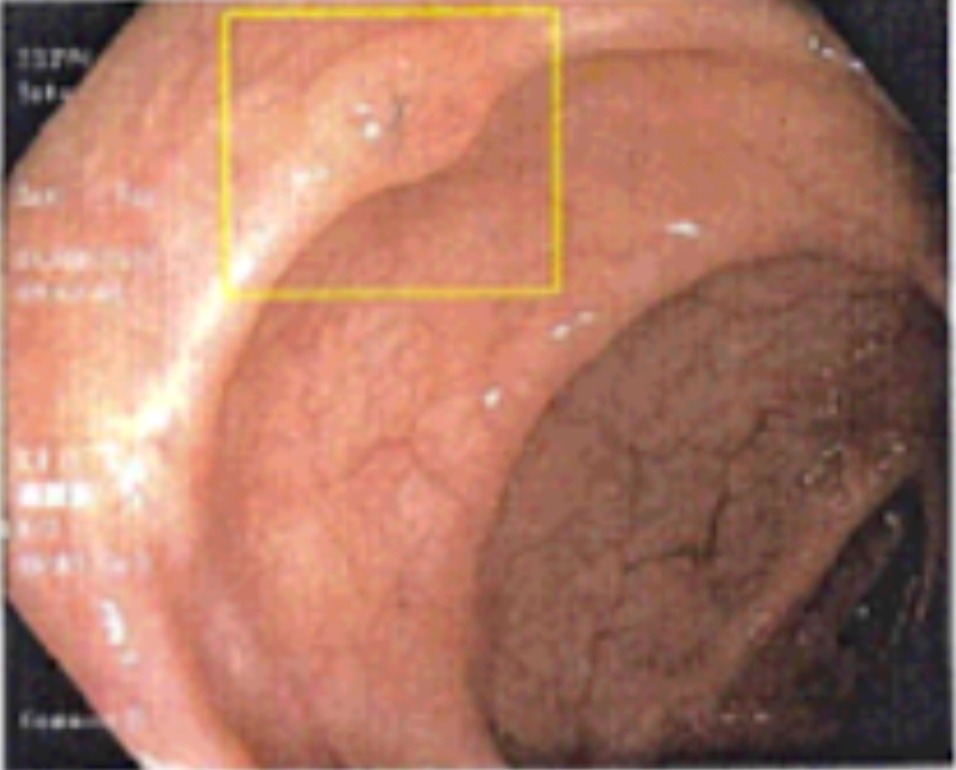Sunday Poster Session
Category: Colon
P0285 - Beyond the Surface: Langerhans Histiocytosis and Colon Polyps Under the Microscope
Sunday, October 22, 2023
3:30 PM - 7:00 PM PT
Location: Exhibit Hall

Has Audio

Jose I. De Arrigunaga, DO
University of Texas Health Science Center at San Antonio
San Antonio, TX
Presenting Author(s)
Jose I.. De Arrigunaga, DO1, Umar Siddiqui, DO2, Alfredo Camero, MD3
1University of Texas Health Science Center at San Antonio, San Antonio, TX; 2University of Texas Health Science Center-San Antonio, San Antonio, TX; 3Gastroenterology Consultants of Laredo, Laredo, TX
Introduction: Langerhans cell histiocytosis (LCH) is a rare disease that commonly occurs in children but can also be found in adults. It involves the excess production of Langerhans cells (histiocytes), a type of white blood cell found in normal adults that protects the body from infection. Excess Langerhans cells can cause tumors called granulomas to form. These granulomas typically cause local damage and form in the skin, nails, mouth, bones, lymph nodes, and endocrine glands. However, LCH is rarely found in the colon. In this case, a middle-aged male underwent a screening colonoscopy, and LCH was incidentally found within a colon polyp.
Case Description/Methods: A 49-year-old male with a past medical history of papillary thyroid carcinoma (in remission) underwent a screening colonoscopy. This was the patient's first colonoscopy, and he did not report any abdominal pain, diarrhea, constipation, changes in bowel movements, rectal bleeding, fevers, chills, nausea, and vomiting. Family history was negative for colon cancer. Physical examination was unremarkable. During the colonoscopy, five polyps ranging 3 to 5 millimeters were found from the ascending colon to the sigmoid colon and subsequently resected with a cold snare. On the initial pathology report, four out of the five polyps were identified as tubular adenomas. However, one of the polyps (Image 1) displayed polypoid colonic mucosa with a collection of atypical histiocytes. The final pathology report confirmed a diagnosis of LCH. Given these findings, the patient was referred to Hematology for further management.
Discussion: LCH is a rare disease that typically affects children and occasionally occurs in adults. Most cases occur in male children with the annual incidence in children being three to five cases per million. In comparison, the annual incidence for adults is one to two cases per million. Gastrointestinal involvement of LCH in adults is extremely rare, with fewer than forty reported cases in the literature. Among those cases, only twenty of them involved the colon. Like this case, most of the colon cases reported were of asymptomatic patients who were found to have a solitary polypoid lesion on screening colonoscopy. Fortunately, adults with solitary polyps and no systemic disease have a good prognosis with a 99% survival rate after local excision. However, ulcerative lesions or multiple polyps can develop into a multisystem disease requiring repeat colonoscopy with Hematology follow-up.

Disclosures:
Jose I.. De Arrigunaga, DO1, Umar Siddiqui, DO2, Alfredo Camero, MD3. P0285 - Beyond the Surface: Langerhans Histiocytosis and Colon Polyps Under the Microscope, ACG 2023 Annual Scientific Meeting Abstracts. Vancouver, BC, Canada: American College of Gastroenterology.
1University of Texas Health Science Center at San Antonio, San Antonio, TX; 2University of Texas Health Science Center-San Antonio, San Antonio, TX; 3Gastroenterology Consultants of Laredo, Laredo, TX
Introduction: Langerhans cell histiocytosis (LCH) is a rare disease that commonly occurs in children but can also be found in adults. It involves the excess production of Langerhans cells (histiocytes), a type of white blood cell found in normal adults that protects the body from infection. Excess Langerhans cells can cause tumors called granulomas to form. These granulomas typically cause local damage and form in the skin, nails, mouth, bones, lymph nodes, and endocrine glands. However, LCH is rarely found in the colon. In this case, a middle-aged male underwent a screening colonoscopy, and LCH was incidentally found within a colon polyp.
Case Description/Methods: A 49-year-old male with a past medical history of papillary thyroid carcinoma (in remission) underwent a screening colonoscopy. This was the patient's first colonoscopy, and he did not report any abdominal pain, diarrhea, constipation, changes in bowel movements, rectal bleeding, fevers, chills, nausea, and vomiting. Family history was negative for colon cancer. Physical examination was unremarkable. During the colonoscopy, five polyps ranging 3 to 5 millimeters were found from the ascending colon to the sigmoid colon and subsequently resected with a cold snare. On the initial pathology report, four out of the five polyps were identified as tubular adenomas. However, one of the polyps (Image 1) displayed polypoid colonic mucosa with a collection of atypical histiocytes. The final pathology report confirmed a diagnosis of LCH. Given these findings, the patient was referred to Hematology for further management.
Discussion: LCH is a rare disease that typically affects children and occasionally occurs in adults. Most cases occur in male children with the annual incidence in children being three to five cases per million. In comparison, the annual incidence for adults is one to two cases per million. Gastrointestinal involvement of LCH in adults is extremely rare, with fewer than forty reported cases in the literature. Among those cases, only twenty of them involved the colon. Like this case, most of the colon cases reported were of asymptomatic patients who were found to have a solitary polypoid lesion on screening colonoscopy. Fortunately, adults with solitary polyps and no systemic disease have a good prognosis with a 99% survival rate after local excision. However, ulcerative lesions or multiple polyps can develop into a multisystem disease requiring repeat colonoscopy with Hematology follow-up.

Figure: Image 1
Disclosures:
Jose De Arrigunaga indicated no relevant financial relationships.
Umar Siddiqui indicated no relevant financial relationships.
Alfredo Camero indicated no relevant financial relationships.
Jose I.. De Arrigunaga, DO1, Umar Siddiqui, DO2, Alfredo Camero, MD3. P0285 - Beyond the Surface: Langerhans Histiocytosis and Colon Polyps Under the Microscope, ACG 2023 Annual Scientific Meeting Abstracts. Vancouver, BC, Canada: American College of Gastroenterology.
